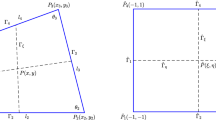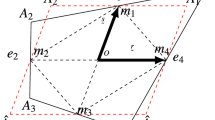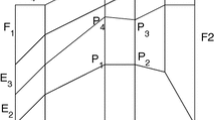Abstract
In this paper, we investigate the spectral method for fourth-order problems defined on quadrilaterals. Some results on the Legendre irrational orthogonal approximations are established, which play important roles in the related spectral method on quadrilaterals. As examples of applications, we provide spectral schemes for a model problem with various boundary conditions. The spectral accuracy of suggested algorithms are proved. Numerical results demonstrate the effectiveness of suggested algorithms, and confirm the analysis well. The approximation results and techniques developed in this paper are also applicable to other fourth-order problems defined on quadrilaterals.

Similar content being viewed by others
References
Belhachmi, Z., Bernardi, C., Karageorghis, A.: Spectral element discretization of the circular driven cavity, part II: the bilaplacian equation. SIAM J. Numer. Anal. 38, 1926–1960 (2001)
Bernardi, C., Maday, Y.: Spectral methods. In: Ciarlet, P.G., Lions, J.L. (eds.) Handbook of Numerical Analysis, pp. 209–486. Elsevier, Amsterdam (1997)
Bernardi, C., Maday, Y., Rapetti, F.: Discretisations Variationnelles de Problemes aux Limites Elliptique, Collection: Mathematique et Applications, vol. 45. Springer, Berlin (2004)
Bert, C.W.: Nonlinear vibration of a rectangular plate arbitrary laminated of anisotropic materials. J. Appl. Mech. 40, 425–458 (1973)
Bialecki, B., Karageorghis, A.: A Legendre spectral Galerkin method for the biharmonic Dirichlet problem. SIAM J. Sci. Comput. 22, 1549–1569 (2000)
Bjørstad, P.E., Tjøstheim, B.P.: Efficient algorithms for solving a fourth-order equation with spectral-Galerkin method. SIAM J. Sci. Comput 18, 621–632 (1997)
Brenner, S.C., Scott, L.R.: The Mathematical Theory of Finite Element Methods, 3rd edn. Springer, Berlin (2008)
Canuto, C., Hussaini, M.Y., Quarteroni, A., Zang, T.A.: Spectral Methods. Springer, Berlin (2006)
Canuto, C., Hussaini, M.Y., Quarteroni, A., Zang, T.A.: Spectral Methods: Evolution to complex Geometries and Applications to Fluid Dynamics. Springer, Berlin (2007)
Chia, C.Y.: Nonlinear Analysis of Plates. McGraw-Hill, New York (1980)
Doha, E.H., Bhrawy, A.H.: Efficient spectral-Galerkin algorithms for direct solution of fourth-order differential equations using Jacobi polynomials. Appl. Numer. Math. 58, 1224–1244 (2008)
Funaro, D.: Polynomial Approxiamtions of Differential Equations. Springer, Berlin (1992)
Guo, B.-Y.: Spectral Methods and Their Applications. World Scientific, Singapore (1998)
Guo, B.-Y.: Jacobi approximations in certain Hilbert spaces and their applications to singular differential equations. J. Math. Anal. Appl. 243, 373–408 (2000)
Guo, B.-Y.: Some progress in spectral methods. Sci. China Math. 56, 2411–2438 (2013)
Guo, B.-Y., Jia, H.-L.: Spectral method on quadrilaterals. Math. Comput. 79, 2237–2264 (2010)
Guo, B.-Y., Shen, J., Wang, L.-L.: Optimal spectral-Galerkin methods using generalized Jacobi polynomials. J. Sci. Comput. 27, 305–322 (2006)
Guo, B.-Y., Sun, T., Zhang, C.: Jacobi and Laguerre quasi-orthogonal approximations and related interpolations. Math. Comput. 82, 413–441 (2013)
Guo, B.-Y., Wang, L.-L.: Jacobi approximations in non-uniformly Jacobi-weighted Sobolev spaces. J. Approx. Theory 128, 1–41 (2004)
Guo, B.-Y., Wang, L.-L.: Error analysis of spectral method on a triangle. Adv. Comput. Math. 26, 473–496 (2007)
Guo, B.-Y., Wang, T.-J.: Composite Laguerre-Legendre spectral method for fourth-order exterior problems. J. Sci. Comput. 44, 255–285 (2010)
Guo, B.-Y., Wang, Z.-Q., Wan, Z.-S., Chu, D.-L.: Second order Jacobi approximation with applications to fourth-order differential equations. Appl. Numer. Math. 55, 480–520 (2005)
Harras, B., Benamar, R., White, R.G.: Investigation of nonlinear free vibrations of fully clamped symmetrically laminated carbon-fibre-reinforced PEEK(AS4/APC2) rectangular composite panels. Compos. Sci. Technol. 62, 719–727 (2002)
Jia, H.-L., Guo, B.-Y.: Petrov–Galerkin spectral element method for mixed inhomogeneous boundary value problems on polygons. Chin. Ann. Math. 31B, 855–878 (2010)
Karniadakis, G.E., Sherwin, S.J.: Spectral/hp Element Methods for CFD, 2nd edn. Oxford University Press, Oxford (2005)
Narita, Y.: Combinations for the free-vibration behaviors of anisotropic rectangular plates under general edge conditions. J. Appl. Mech. 67, 568–573 (2000)
Reddy, J.N.: A simply higher-order theory for laminated composite plates. J. Appl. Mech. 51, 745–754 (1984)
Shen, J., Tang, T., Wang, L.-L.: Spectral Methods: Algorithms, Analysis and Applications. Springer, Berlin (2011)
Yu, X.-H., Guo, B.-Y.: Spectral element method for mixed inhomogeneous boundary value problems of fourth order. J. Sci. Comput. 61, 673–701 (2014)
Acknowledgments
We thank professor Hu Jun of Peking University for helpful discussions.
Author information
Authors and Affiliations
Corresponding author
Additional information
This work is supported in part by NSF of China N.11171227 and N.11426155, Fund for Doctoral Authority of China N.20123127110001, Fund for E-institute of Shanghai Universities N.E03004, Leading Academic Discipline Project of Shanghai Municipal Education Commission N.J50101, and the Hujiang Foundation of China (B14005).
Appendix
Appendix
This appendix is devoted to the lifting technique. The edges \(L_i\) of domain \(\Omega \) are as follows (see Fig. 1),
Let \(l_{i+4}(x,y)=l_i(x,y),~i=1,2,3,4\). We could rewrite the equations corresponding to the edges as \(x=x_i(y)\) for \(L_i,i=1,3\), and \(y=y_i(x)\) for \(L_i,i=2,4\). Clearly,
We denote the normal vector of edges \(L_i\) by \(n_i=(\cos \alpha _i,\cos \beta _i)^T,~1\le i\le 4\). Besides, \(Q_i\) stand for the four corners of domain \(\Omega \) as in Fig. 1.
Our aim is to design the lifting function \(v_b(x,y)\) such that
where \(g_i(y),h_i(y) (i=1,3)\) and \(g_i(x),h_i(x)(i=2,4)\) are given functions. In addition, the functions \(g_i(y)\) and \(g_i(x)\) fulfill certain consistent conditions ensuring the continuity of \(v_b(x,y)\) at the corners of domain.
In the forthcoming discussions, we introduce the following polynomials,
It can be checked that
We also introduce the following polynomials,
It can be verified that
We can also verify that \(\sigma _{ij}(x,y),2\le i,j\le 4\) have the same properties. Accordingly, we design the desired lifting function \(v_b(x,y)\) satisfying (A.3) as follows,
where \(\widetilde{g}_i,\widetilde{h}_i\) and \(p_{ij}, 1\le i,j\le 4\) are undetermined functions and constants. We shall construct those undetermined quantities properly in the following four steps.
Step 1 According to (A.3), we use (A.5) and (A.7) to derive that
Furthermore, the corner \(Q_1=L_1\cap L_2\). Thus we know from (A.5) and (A.7) that
Therefore
In other words,
Due to the continuity of \(v_b(x,y)\), we have \(g_1(y)|_{Q_1}=g_2(x)|_{Q_1}\). Thereby, the above expression is meaningful and so determines the constant \(p_{11}\). In the same manner, we can calculate the constants \(p_{i1},\,i=2,3,4\).
Step 2 For simplicity, let \(\partial _x s_1(x_1(y),y)=\partial _x s_1(x,y)|_{x=x_1(y)}\), etc. By differentiating the two equations of (A.9), we derive that
Moreover, we know from (A.5) and (A.7) that at the corner \(Q_1\),
Therefore
Consequently,
These expressions with (A.10) determine the constants \(p_{12}\) and \(p_{13}\). We can calculate the \(p_{i2}\) and \(p_{i3},~i=2,3,4\) in the same way.
Furthermore, we obtain from the first equation of (A.9) that
Since \(p_{ij},\,1\le i\le 4,1\le j\le 3\) are given already by (A.10) and (A.13), the above expressions determine the functions \(\widetilde{g}_1(y)\). We also can determine the functions \(\widetilde{g}_2(x),\widetilde{g}_3(y)\) and \(\widetilde{g}_4(x)\).
Step 3 According to (A.3), we use (A.5) and (A.7) to derive that
Then, we have
Moreover, due to \(g_1(y)=u(x_1(y),y),~g_4=u(x,y_4(x))\) and (A.4), we find that
From the first equation of (A.15) and (A.16), we have
From the second equation of (A.15) and (A.16), we have
Then, we obtain the compatibility conditions as \(\partial _{xy}u(x,y)|_{Q_1}=\frac{A_{Q_1}}{B_{Q_1}}=\frac{C_{Q_1}}{D_{Q_1}}\).
Next, by differentiating the (A.8) twice, we derive that
Moreover, we know form (A.5) and (A.7) that
Therefore,
Consequently,
In the same manner, we can determine the constants \(p_{i4},~1\le i\le 4\).
Step 4 According to (A.3), we use (A.5) and (A.7) to derive that
Moreover, with the aid of (A.5), we deduce that
By substituting the above equality into (A.20), we obtain
which determines the function \(\widetilde{h}_1(y)\).
In the same way, we can determine the functions \(\widetilde{h}_2(x),\,\widetilde{h}_3(y)\) and \(\widetilde{h}_4(x)\).
Finally, a combination of (A.10), (A.13), (A.14), (A.19) and (A.21) leads to the desired lifting function (A.8).
Remark 5.1
We can construct the lifting function for the boundary condition corresponding to the mixed inhomogeneous boundary value problems of fourth order.
Rights and permissions
About this article
Cite this article
Yu, Xh., Guo, By. Spectral Method for Fourth-Order Problems on Quadrilaterals. J Sci Comput 66, 477–503 (2016). https://doi.org/10.1007/s10915-015-0031-6
Received:
Revised:
Accepted:
Published:
Issue Date:
DOI: https://doi.org/10.1007/s10915-015-0031-6
Keywords
- Orthogonal approximation on quadrilaterals
- Spectral method for fourth-order problems
- Mixed boundary value problems




